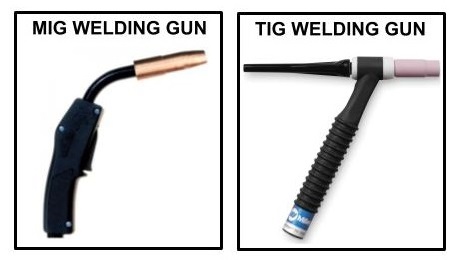Both TIG and MIG welding are the type of arc welding that utilizes electric arc in the presence of inert gas to create the welded joint. Both techniques have their advantages and limitations.
Choosing the best welding technique ensures a good quality welded joint. In this article, we will discuss the difference between TIG vs MIG Welding. It will help you in the selection of the best type of welding for your application. Click this Link to Know in detail about Electron Beam Welding Process.
What is the difference Between TIG and MIG Welding?
TIG and MIG welding techniques are different according to various parameters such as welding process, quality, and cost involved, etc. Here is the list of differences between the TIG and MIG welding processes.
Welding Process

In MIG welding, a feed wire moves constantly through the MIG welding gun to generate the spark. To weld the parts, spark melts the feed wire and fuse it between the base material to be joined.
Whereas in TIG welding, a non-consumable tungsten electrode is used to create the spark or arc. Afterward, arc melts the base and filler material to create a welded joint. Therefore in TIG welding, welders can control the speed and depth of weld more precisely compared to MIG welding.
Base Material
In Metal Inert Gas or MIG welding, feed wire works as an electrode and filler rod. Therefore welding thicker parts are possible without heating parts to their melting temperature.
In TIG welding, you can weld different materials because a separate filler rod is used.
Therefore we can conclude that MIG welding is the best option for very thick and heavy-duty welds. Whereas TIG welding is a more effective solution for welding thin and dissimilar material parts.
Weld Quality
TIG welding produces finer and clean welds compared to MIG welding.
Welding Cost
The metal inert gas welding process is fast compared to TIG welding. As a result, MIG welding labor cost is less compared to TIG welding.
MIG welding equipment is also cheaper and readily available compared to Tungsten Inert Gas welding equipment.
Ease of Use
In tig welding, the welder has to use both hands and one foot to weld parts. Therefore specialized technique is required to weld parts. In MIG welding, the welder needs one hand only. Therefore MIG welding is easier to operate compared to TIG welding.
Precision
In TIG welding, the welder has more control over the gun and heat produced. Therefore it is more precise compared to MIG Welding.
Welding Speed
MIG welding has a very high speed compared to TIG welding process.
Weld Strength
TIG welding produces high strength welds compared to MIG welding
Cleanliness
TIG welding is a relatively clean process compared to MIG welding. Because in TIG welding, the welder has more control over filler material. Therefore spatter produced during welding is reduced. Whereas, MIG welding produces more smoke, fumes, and sparks.
TIG vs MIG Welding
| Properties | TIG Welding | MIG Welding |
|---|---|---|
| Electrode Type | Non-Consumable Electrode | Consumable Electrode |
| Base Material | Dissimilar material welding is possible. | Only similar materials can be welded. |
| Weld Quality | Fine and clean weld joint. | Weld quality is not very good. |
| Cost | High cost. | Low cost compared to TIG welding. |
| Ease of Use | An expert operator is required. | Relatively easy to operate. |
| Precision | High precision weld. | Used for heavy welding work. |
| Welding Speed | Relatively slow process. | More efficient and productive. |
| Weld Strength | Low Strength | High Strength |
To sum up, MIG welding is typically better for heavy-duty welding. Whereas TIG welding works best for joining small metal parts. TIG welding can also join two pieces of metal without a filler rod. Click this link to understand various sheet metal joining operations.
We will keep adding more details on the difference between tig and mig welding techniques. Add your suggestions, comments or questions on TIG vs MIG welding in the comment box.

Add a Comment